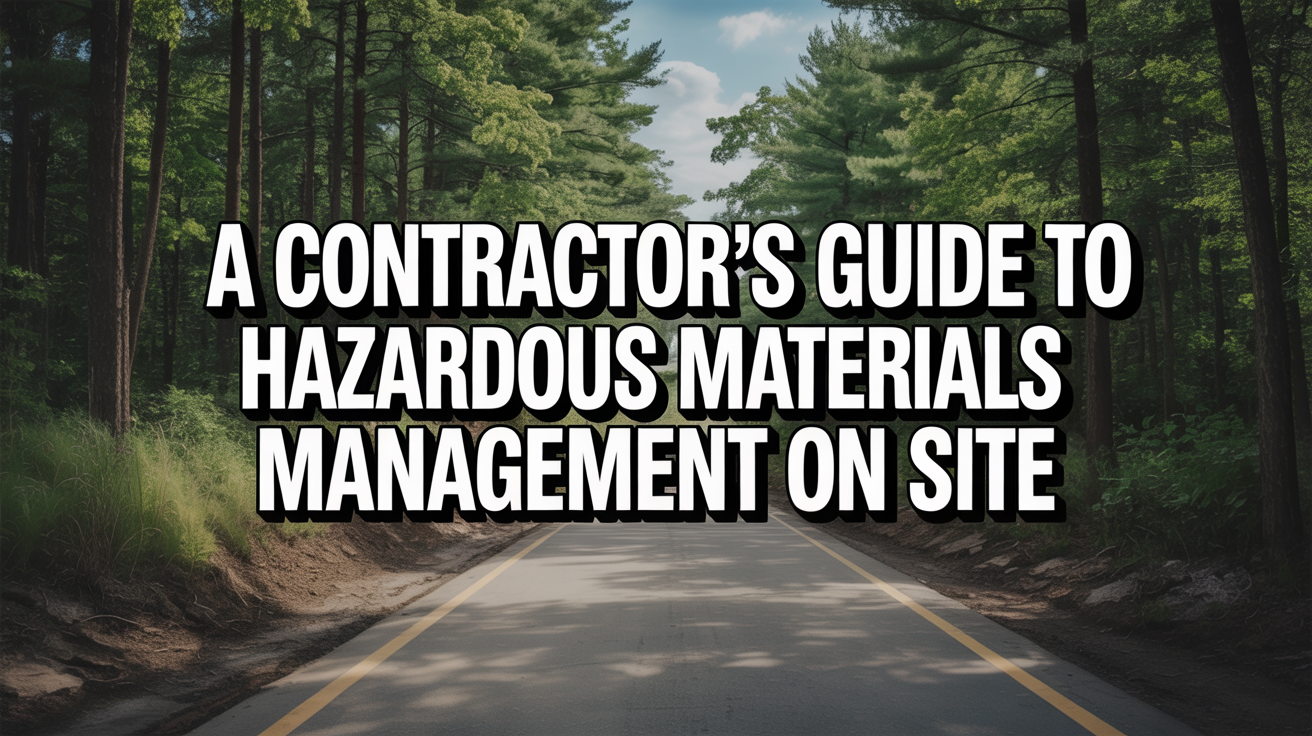A Contractor’s Guide to Hazardous Materials Management on Site
Managing hazardous materials is a critical responsibility for contractors, as these substances are often present on construction sites and can pose serious risks. From health hazards to environmental damage, improper handling of hazardous materials can lead to accidents, project delays, and even legal consequences. Not only is managing these materials a regulatory requirement, but it’s also essential for protecting workers and ensuring that projects stay on track. The stakes are high, and contractors must prioritize safety and compliance to avoid costly setbacks. 🚧
This guide will walk you through the key aspects of hazardous materials management, including identification, handling, storage, disposal, and compliance. Whether you’re working on new construction or renovating older buildings, understanding these protocols is crucial. Many older structures contain banned substances like asbestos or lead, making it vital for contractors to know how to manage these risks effectively. With the right strategies in place, you can protect your team, the environment, and your project timeline. 🌱
Understanding Hazardous Materials in Construction
Hazardous materials in construction refer to any chemicals, substances, or waste products that could harm human health or the environment. These materials can be found in various forms, from liquids and gases to solids and dust. In construction, hazardous materials are typically grouped into categories such as carcinogens, corrosives, flammables, and toxic substances. Understanding these categories is the first step toward effective management. 🔍
Contractors frequently encounter hazardous materials like asbestos, lead, PCBs, silica dust, solvents, fuels, oils, paints, adhesives, and other chemical products. Many of these materials were commonly used in buildings constructed before stricter regulations were introduced in the 1970s. For instance, asbestos was widely used for insulation, while lead-based paints were standard in many structures. Being aware of these materials helps contractors anticipate potential risks and plan accordingly. 🏗️
Exposure to hazardous materials can lead to severe health issues, including respiratory problems, cancer, skin conditions, and environmental contamination. Workers who inhale silica dust or handle lead-based products without proper protection are at significant risk. Early identification of these hazards is crucial to prevent accidents and long-term health effects. By taking proactive steps to manage hazardous materials, contractors can safeguard their teams and the surrounding environment. 🩺
Developing a Comprehensive Hazardous Materials Management Plan
Creating a Hazardous Materials Management Plan (HMMP) is a foundational step for any construction project. This plan serves as a roadmap for identifying, handling, storing, and disposing of hazardous materials safely. A well-structured HMMP ensures compliance with regulations and provides clear guidelines for all personnel involved. It’s not just a formality-it’s a tool that protects workers and keeps the project running smoothly. 📋
An effective HMMP should include several key components, such as a chemical inventory list, waste management procedures, storage and handling protocols, and emergency response plans. It should also outline the roles and responsibilities of everyone on site, from supervisors to laborers. Additionally, the plan should describe how to maximize waste diversion and minimize disposal requirements. By addressing these elements, contractors can create a robust framework for managing hazardous materials throughout the project lifecycle. 🛠️
The HMMP should be reviewed by occupational health and safety experts to ensure it meets all regulatory standards. It must also be accessible to all site personnel, so everyone knows what’s expected of them. As the project progresses, the plan should be updated to reflect new hazards or changes in site conditions. Regular reviews and updates ensure that the HMMP remains relevant and effective, providing ongoing protection for workers and the environment. 🔄
Training and Educating Your Team
Training is a non-negotiable aspect of hazardous materials management. All employees who will handle or work near hazardous substances must receive thorough training before they begin their tasks. This training should be tailored to the specific materials they’ll encounter on the job, ensuring they understand the risks and how to mitigate them. Proper education empowers workers to stay safe and respond effectively in case of emergencies. 🎓
Effective training programs cover a wide range of topics, including hazard recognition, the proper use of personal protective equipment (PPE), safe handling and storage practices, and emergency response protocols. Spill cleanup procedures are also an essential part of the curriculum. Refresher training should be conducted regularly to keep workers proactive about safety and reinforce their knowledge. Hands-on sessions and simulations can make training more engaging and practical. 🧴
“A detailed hazard communication program ensures workers are informed about risks from hazardous materials. It should include a chemical inventory, SDSs, labeling, and regular training to maintain a safe workplace.” -SafetyCulture
Documenting training sessions is crucial for compliance and accountability. Contractors should maintain detailed records of who attended each session and what topics were covered. This documentation proves that the team is prepared to handle hazardous materials safely. Additionally, it’s important to ensure that all personnel understand their specific roles in the hazardous materials management program. Clear communication fosters a culture of safety and responsibility on site. ✍️
Implementing a Hazard Communication Program
A hazard communication program is a cornerstone of workplace safety when dealing with hazardous materials. This program ensures that workers are informed about the risks associated with the chemicals they encounter on site. By providing clear and consistent information, contractors can foster a safer work environment and meet regulatory requirements. Effective communication is key to preventing accidents and protecting workers. 🗣️
Safety Data Sheets (SDSs) are a critical component of any hazard communication program. These documents provide detailed information about the properties, hazards, handling procedures, and emergency response measures for each chemical on site. SDSs must be readily accessible to all workers, either in physical or digital formats. Having this information at hand allows workers to make informed decisions and take appropriate precautions when handling hazardous materials. 📂
Proper labeling of hazardous material containers is equally important. Labels should clearly identify the chemical name, hazard warnings, and handling precautions. Pictograms and symbols can help convey risks quickly and effectively. When containers are properly labeled, there’s less room for confusion, reducing the likelihood of accidental exposure. A well-implemented labeling system is a simple yet powerful way to enhance safety on site. 🏷️
Safe Storage and Handling Procedures
Storing hazardous materials safely is a top priority for contractors. Designated material yards or storage areas should be used whenever possible, ideally on private land adjacent to the project site. These areas should be located away from sensitive resources like water bodies or residential zones to minimize risks. Proper storage not only protects workers but also prevents environmental contamination. 🏭
“Hazardous materials would be stored only in designated areas on impervious surfaces, on plastic groundcovers, or with secondary containment, to prevent spills or leaks from infiltrating the ground.” -BLM Oberon Project HMMP
Secondary containment is a critical requirement for storing hazardous materials. Containment structures must be able to hold 110 percent of the volume of the largest container, with additional space for precipitation. Options for secondary containment include spill containment pallets, earthen berms lined with plastic, concrete containment pits, and double-walled storage tanks. These measures ensure that spills or leaks are contained and don’t spread to the surrounding environment. 🛡️
Safe handling practices are just as important as proper storage. Incompatible chemicals should be kept separate to prevent dangerous reactions. Heavy containers should be placed on lower shelves to reduce the risk of spills, and storage areas should have adequate ventilation. Regular inspections are essential to detect leaks or damage early. Limiting the quantities of hazardous materials stored near water bodies further reduces environmental risks. 🧪
Adequate lighting in storage and handling areas ensures that workers can see what they’re doing, reducing the likelihood of accidents. Absorbent materials and containment booms should be readily available for quick cleanup of minor spills. Trained personnel should monitor all activities involving hazardous materials to ensure compliance with safety protocols. These measures help maintain a safe and organized work environment. 💡
Personal Protective Equipment Requirements
Personal protective equipment (PPE) plays a vital role in shielding workers from hazardous material exposure. The specific PPE required depends on the nature of the hazards and the tasks being performed. From gloves and goggles to respirators and full-body suits, PPE acts as the last line of defense against potential dangers. Ensuring that workers have the right equipment is a fundamental part of hazardous materials management. 🦺
Common types of PPE used on construction sites include respiratory protection, eye and face protection, hand protection, and protective clothing. Specialized equipment may be needed for specific hazards, such as chemical-resistant gloves for handling solvents. Contractors should conduct hazard assessments to determine the appropriate PPE for each situation. Selecting the right gear is crucial for ensuring worker safety and compliance with regulations. 👷♂️
“Employers must train all employees to handle and use hazardous materials before they start work safely. Regular training beyond the basics helps employees stay proactive about safety and respond effectively to incidents.” -SafetyCulture
Regular maintenance, inspection, and replacement of PPE are essential to ensure its effectiveness. Respirators, in particular, require proper fit testing to guarantee they provide adequate protection. PPE should always be used in conjunction with other control measures, such as engineering controls and administrative practices. By prioritizing PPE maintenance, contractors can ensure their teams are well-protected on the job. 🔧
What to Do When You Discover Hazardous Materials
Discovering unexpected hazardous materials on a construction site can be alarming, but it’s important to act quickly and decisively. The first step is to stop work immediately in the affected area to protect worker safety. Continuing work without addressing the hazard could lead to serious consequences, including health risks and legal liabilities. Prompt action is crucial to prevent further exposure. ⚠️
Once the hazard is identified, contractors must notify the owner, architect, and relevant regulatory authorities. Keeping all personnel away from the affected area is essential until professional testing and verification can be completed by licensed laboratories. This step ensures that no one is exposed to potentially dangerous substances while the situation is being assessed. Clear communication and coordination are key during this process. 📞
Professional assessment and abatement services should be engaged to evaluate the situation and determine the best course of action. Work should only resume once written mutual agreement confirms that the area is safe. Contractors should never attempt to handle or remove unknown hazardous materials themselves, as this could lead to accidents or regulatory violations. Professional expertise is invaluable in these situations. 🏢
The discovery of hazardous materials can have contractual and financial implications. Contractors may need to negotiate change orders to adjust project timelines and costs related to shutdowns, delays, and restarts. Proper documentation of the discovery and response is essential for protecting the contractor’s interests. By keeping detailed records, contractors can demonstrate due diligence and avoid disputes. 📊
“The first step should be to immediately stop work in the affected area and notify the owner and architect.” -AIA Contracts
Site Control and Emergency Response
Establishing clear site control measures is essential for preventing unauthorized access to hazardous materials storage and handling areas. A site map should clearly identify all hazardous material locations, restricted zones, and emergency equipment stations. These measures help maintain order and reduce the risk of accidents. Proper site control is a proactive way to enhance safety. 📍
An effective emergency response plan includes designated coordinators, communication protocols, evacuation procedures, and specific actions for different types of incidents, such as spills, fires, or exposures. This plan ensures that everyone knows what to do in an emergency, minimizing confusion and response times. A well-prepared team can handle crises more effectively. 🚨
Site supervisors and emergency coordinators play critical roles in enforcing the hazardous materials management plan and coordinating responses. All personnel should understand their specific roles during an emergency, whether it’s evacuating the area, containing a spill, or administering first aid. Clear roles and responsibilities ensure a coordinated and efficient response. 🤝
Emergency equipment, such as spill kits, fire extinguishers, eyewash stations, and first aid supplies, should be readily available on site. Regular drills and exercises help personnel practice their response skills and identify areas for improvement. Preparedness is key to ensuring that everyone can react quickly and effectively in an emergency. 🧯
Decontamination Procedures
Decontamination procedures are designed to prevent the spread of hazardous materials from work areas to clean areas or off-site. These processes protect workers, prevent cross-contamination, and reduce the risk of exposure. Implementing standardized decontamination protocols is a critical part of maintaining a safe work environment. 🚿
“Ensure the proper PPE is available and used consistently for handling specific hazardous materials. It includes gloves, goggles, masks, protective clothing, and first-aid kits designed for the hazards present.” -SafetyCulture
Personnel decontamination involves removing protective equipment in a specific sequence, washing and rinsing thoroughly, and disposing of contaminated materials properly. Decontamination zones should be established, with clear flow paths for personnel moving through these areas. Standard operating procedures and checklists ensure consistency and effectiveness. 🧼
Equipment decontamination is equally important, as tools, machinery, and vehicles that come into contact with hazardous materials must be cleaned thoroughly. Cleaning methods may include washing, scrubbing, or using specialized cleaning agents. Standardizing these procedures ensures that all equipment is properly decontaminated before reuse or removal from the site. 🛠️
Documentation and Record Keeping
Maintaining comprehensive documentation is a cornerstone of effective hazardous materials management. Proper records demonstrate compliance, support insurance claims, and protect contractors in case of disputes or regulatory investigations. Detailed documentation is a valuable asset for any construction project. 📑
Records should include chemical inventories with storage locations and quantities, Safety Data Sheets (SDSs), training documentation, exposure monitoring results, incident reports, waste manifests, and disposal records. Each type of document has specific retention requirements, which contractors must adhere to. Organized record keeping ensures that all necessary information is readily available when needed. 📚
Digital tools and software can streamline hazardous materials documentation, from inventory tracking systems to electronic SDSs and mobile inspection apps. These tools improve efficiency and accessibility, allowing workers, emergency responders, and regulatory inspectors to access information quickly. Embracing technology enhances both compliance and safety. 💻
Proper Disposal of Hazardous Waste
Hazardous waste disposal is governed by a complex regulatory framework that contractors must navigate carefully. Federal, state, and local regulations dictate how waste should be classified, packaged, labeled, and transported. Contractors are responsible for complying with these rules, which vary based on the quantity of waste produced. Proper disposal is essential for protecting the environment and avoiding penalties. 🗑️
Characterizing, packaging, and labeling hazardous waste correctly is crucial for safe transportation and disposal. Licensed waste haulers and approved disposal facilities must be used to ensure compliance. Waste manifests that track materials from “cradle to grave” are mandatory, providing a clear record of disposal activities. Following these procedures minimizes risks and ensures accountability. 🚛
Minimizing hazardous waste generation through source reduction, material substitution, and recycling is a smart strategy. Not only does this approach reduce disposal costs, but it also decreases environmental impact and regulatory burden. By adopting waste minimization practices, contractors can contribute to sustainability while improving their bottom line. ♻️
Regulatory Compliance and OSHA Standards
Contractors must comply with multiple regulatory frameworks governing hazardous materials on construction sites, including OSHA standards, EPA requirements, and DOT transportation rules. Understanding these regulations is essential for ensuring compliance and avoiding penalties. Navigating this complex landscape requires careful attention to detail and a proactive approach. 📜
Specific OSHA standards apply to construction sites, such as the Hazard Communication Standard, respiratory protection requirements, PPE standards, and standards for substances like lead and asbestos. Contractors must determine which standards are relevant to their projects and ensure full compliance. Staying informed about regulatory updates is crucial for maintaining safety and legality. 🏭
Non-compliance can result in fines, stop-work orders, legal liability, and reputational damage. Conducting regular compliance audits and working with safety professionals can help contractors stay on track. Investing in compliance not only protects workers and the environment but also enhances a contractor’s reputation as a responsible and trustworthy partner. 🛡️
Frequently Asked Questions
What should a contractor do immediately upon discovering asbestos or other hazardous materials on a construction site?
Upon discovering asbestos or other hazardous materials, contractors must immediately stop work in the affected area, notify the owner and architect, and keep all workers away until professional testing and abatement are completed. Work should only resume after written confirmation that the area is safe. 🚧
What are the secondary containment requirements for storing hazardous materials on site?
Secondary containment structures must hold 110 percent of the volume of the largest container, with sufficient freeboard for precipitation. Acceptable methods include spill pallets, bermed areas, concrete pits, and double-walled tanks. These measures prevent spills from spreading and contaminating the environment. 🛢️
How often should workers receive hazardous materials training?
Workers should receive initial training before handling hazardous materials and refresher training regularly. The frequency may depend on regulatory requirements, changes in site conditions, or the introduction of new hazardous materials. Continuous training ensures workers stay proactive about safety. 📚
What information must be included on hazardous material container labels?
Labels must include the chemical name, hazard warnings, pictograms, handling precautions, and manufacturer information. Proper labeling ensures workers can quickly identify risks and take appropriate precautions. Clear labels are a simple yet effective safety measure. 🏷️
Who is responsible for hazardous materials management on a construction site with multiple contractors?
While the general contractor typically has overall responsibility, each subcontractor is responsible for managing hazardous materials they bring to the site. Clear agreements, coordination, and an on-site supervisor help ensure compliance with the hazardous materials management plan. Collaboration is key to success. 🤝
Conclusion
Effective hazardous materials management is a multifaceted process that requires careful planning, thorough training, proper equipment, and strict adherence to established procedures. While it may seem complex, following systematic approaches to identification, handling, storage, and disposal protects workers, prevents environmental damage, and keeps projects on schedule. Contractors who invest in proper hazardous materials management programs not only ensure compliance but also build safer work environments and stronger reputations. 🌟
Review and update your hazardous materials management programs regularly to ensure they remain effective. Ensure all personnel are properly trained and conduct regular audits of your procedures. Prioritize safety by developing comprehensive Hazardous Materials Management Plans tailored to your specific projects. Maintain meticulous documentation and foster a culture where every team member understands their role in hazardous materials safety. Proactive management of hazardous materials is not just a regulatory requirement-it’s a fundamental responsibility to protect the health and safety of everyone on the construction site. 🛠️



